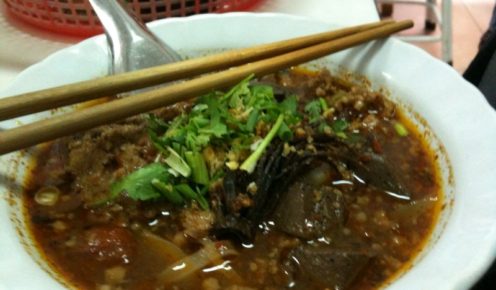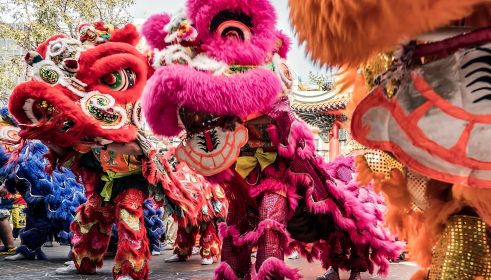CHIANG RAI – Too much of Thai’s Tom Yam Koong or Green Curry? It’s time to try local Northern Thai food. Normally we call the food in this category as “Lanna Food”, where Lanna refers to ancient Kingdom which cover most part of Northern Thailand.
The Lanna Kingdom doesn’t exist anymore but we still refer Northern Thailand part for example Chiang Rai, Chiang Mai, Phayao, Lampang, Nan and Phae to as “Lanna”. So Lanna food simply means the food that originated from Northern part of Thailand.
The way to eat Lanna food, people prefer steamed glutinous rice, traditionally kneaded into small balls with the fingers. As for noodles and curries, they are generally milder than those of central and northeastern Thailand. Traditionally eating in Northern part of Thailand is haunched at small, round tables known as Khantoke tables, see picture below.
If given the chance do not pass on a Khantoke feast as you will be left wonderful experience. Here you will find Northern Thai food at its best. Note that Northern Thai food is not the same as North Eastern Thai food (Isan Food). While Isan food can be found in Northern Thailand it is very different to the foods of Lanna. When you’re in Chiang Rai the below are 11 Lanna food dishes you should try.
1. Khanom Jeen Nam Ngiao – ขนมจีนน้ำเงี้ยว
‘Khanom Jeen Nam Ngiao’ or noodle soup or curry is a-must when you get a chance to be in Chiang Rai. Khanon Jeen means fresh rice noodles and ‘Nam Ngiao’ is spicy tomato infused broth. The combination of both becomes a uniquely Northern Thai noodle soup. Beef or pork (usually pork) is the main ingredient, as well as diced curdled (chicken) blood cake.
Chopped tomatoes give the dish a certain sour flavor and crispy roasted or fried dry chilies and garlic are added for spiciness. Traditional preparation uses minced pork balls and generous chunks of jellified pigs blood, mixed with rices noodles and served in a thin, tomato and spice infused pork broth. Only made better by additions of lime, beansprouts, pickled cabbage and kap moo (deep fried pork skin).
2. Northern Noodle Curry (Khao Soi, ข้าวซอย)
Khao Soi is one of the most popular dishes in Northern Thailand. It is similar to Khanom Jeen Nam Ngiao but is has coconut milk and more rich in flavour. A mild, coconut based curry served over soft egg noodles and topped with crisp egg noodles. Perfected by optional additions of lime, onion, chilli and pickled cabbage. Khao Soi is easily found in both street food and restaurants throughout Northern Thailand and costs around 30 to 50 baht per bowl.
3. Chilli Dips (Nam Prik Ong น้ำพริกอ่อง Nam Prik Noom น้ำพริกหนุ่ม)
The chunky, chile-based family of dips or relishes known as nam phrik are found around Thailand in countless variations. In Northern Thailand, you’re especially likely to run across two of the most popular chili dips. The first is Nam Prik Num, a green, moderately spicy paste that’s generally paired with steamed or blanched vegetables for dipping; sausage is a popular addition to the plate for some protein heft.
There’s also Nam Prik Ong, a dip made with pork and tomatoes that’s frequently referred as “Thai Bolognese” for obvious reasons; it’s usually paired with blanched or steamed veggies and crunchy pork rinds. Just add sticky rice, and you have a light meal or substantial snack.
The popular dishes above are essential eating at every Khantoke table. ‘Nam Prik Ong’ is the more popular of dips a blend of red, birds-eye chillies with pork and tomato. My preferred dipping sauce however is the ‘Nam Prik Noom’ a fiery dip combining flavours of toasted green chilli, onion and garlic. If no feasts planned during your visit you can still find these dips on restaurant menus matched with nibbles of Kap Moo (deep fried pork skins), sticky rice and a selection of vegetables.
4. Northern Pork Curry (Kaeng Hang Lei, แกงฮังเล)
This curry kind of dish is believed to originate from Myanmar but become a favorite dish for Northern Thailand, especially Chiang Mai and Chiang Rai. It is the lease spicy among all other curries and is slightly fruity with tastes of tomato. Of course 100% delicious and makes the perfect curry for those with a less fiery palate. Kaeng Hang Lei brings a slight Burmese influence infusing turmeric with tamarind, ginger and garlic. While popularity doesn’t quite match the Khao Soi curry it does rank highly on Northern Thai menus. This dish is another favorite at Khan Tok feasts.
5. Northern Thai Sausage (Sai Oua, ไส้อั่ว)
Sai Oua is more popular in Chiang Mai than in Chiang Rai, but you can easily find this dish in most market streets in the city. This tasty, spiced pork sausage is found everywhere in the North and is not to be missed. Sai Oua fuses many of the signature Thai tastes; the sour of lemongrass and kaffir lime leaves, the heat of chillies and of course the all important kick from galangal (ginger). These mixtures give Sai Oua a spicy lemony flavor. Sai Oua is normally prepared in spiral lengths the same way a other kind of sausages and sold at most street sides and local markets of Northern Thailand. It is also a big favorite at the Khantok Table. Costs roughly 300 Baht per Kilo and you can but it for 100g each which costs 30 Baht.
6. Lap Moo (ลาบหมู)
Lap moo is a favorite dish for almost all local people. The main ingredients are minced fresh meat (pork with blood and boiled organs which are thinly sliced) mixed with chili paste for lap (roasted dried chilies and several kinds of spices pulverized to a powder or paste).
There are 2 versions of Lap Moo, fresh (or raw), and cooked. Cooked Lap Moo or sometimes called “Lab Khua Moo” can be done by by stir frying it in a little oil. The cooked version is nicely flavored, but sometimes it can be oily for some people. Local people normally eat fresh version of it but we recommend you to try the cooked one.
7. Steamed Rice With Minced Pork and Blood or Kao Kun Jin (ข้าวกั้นจี้น)
If you are one a Northern Thais and accidentally seen this cuisine’s image, you might feel very hungry and you might hear rumbling sound in your stomach. This locals recipe is called “Kao Kun Jin” (ข้าวกั๊นจิ๊น) or “Steamed Rice With Minced Pork and Blood in Banana leaf”. To make this delicious recipe is not too difficult, just follow these instructions :
8. Fermented Pork Sausage (Naem, แหนม)
Naem is a fermented sausage made with minced pork, pork skins, cooked sticky rice (gelatinous), fresh garlic, salt, sugar and bird’s eye chilies. The sausage is wrapped in banana leaves or synthetic casings and fermented for 3-5 to days. It is also one of the few Northern Foods common to Bangkok streets often found sizzling and skewered over hot charcoals at city street food vendors. Naem is usually eaten with sliced ginger, chopped shallots, peanuts, bird’s eye chilies and spring onions. The fresh shallots give the dish a sweet heat that harmonizes well with the sourness of the Naem. We recommend you to try cooked Naem instead of fresh one.
9. Pla Som (ปลาส้ม)
If the rest of the foods on here are great for beginner-level enjoyment, this fermented fish dish typical of the Isaan region might be considered intermediate-tier. Pla Som is believed to be originated from North Eastern Thailand (Isaan), it is one of the most popular dish in Phayao Province (70 kms from Chiang Rai) and you can find it easily in fresh markets in Chiang Rai.
Many people think that is rotten fish of some kind when they first encounter it. But if you stick around, you might just get to like pla som, a whole fish that’s typically coated with a rice-garlic-salt mash and left un-refrigerated for several days. To serve it, people cooks fry the whole fish and accompany it with herbs and sticky rice.
10. Steamed Pork Salad (Yum Moo Yor, ยำหมูยอ)
A boiled pork sausage with white complexion and rubbery texture. Moo Yor is one of the most common Northern Thai Foods and is therefore in need of a mention. Alone Moo Yor doesn’t really compete with the spice of Sai Oua or sour of Naem and because of this I have made a meal of it. The meal is Yum Moo Yor which fuses the Yum Moo steamed pork with a fiery salad of chillies, fish sauce, lime and coriander. A common dish in restaurants of Northern Thailand. For Moo Yor meat you can easily find it at roadside shops, wrapped in green banana leaf and stacked in pyramids. Costs roughly 30 Baht a packet. Feel free to eat whole like a giant, meat sausage.











